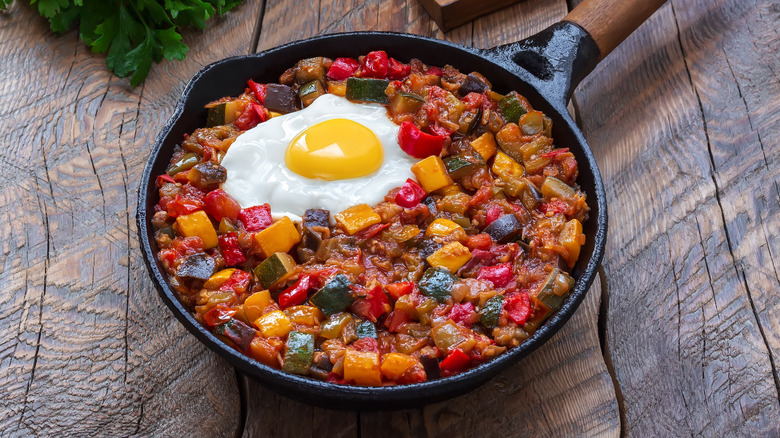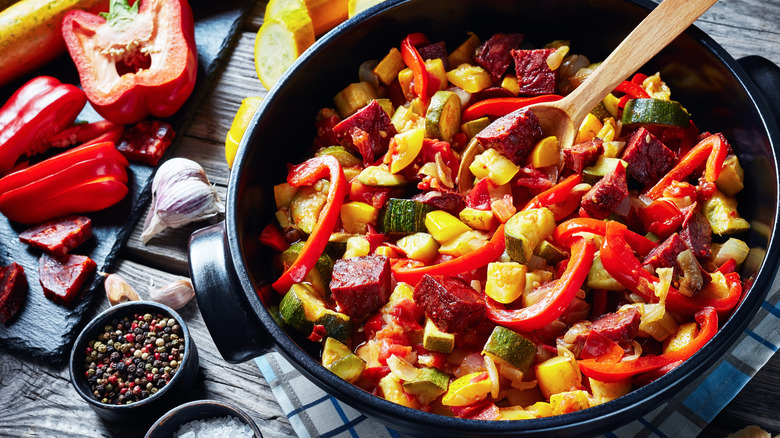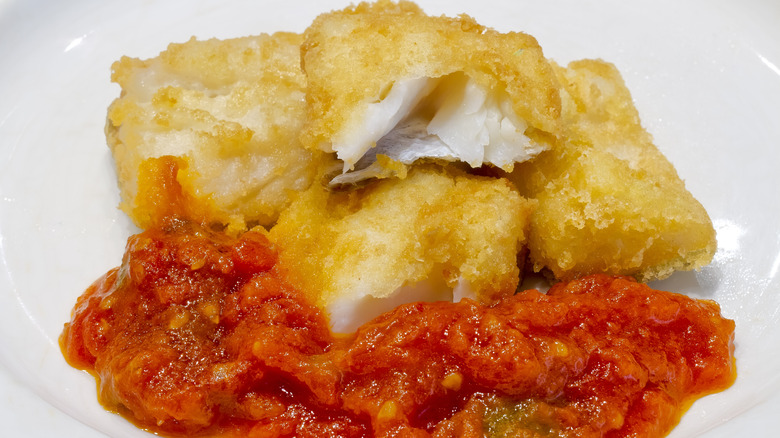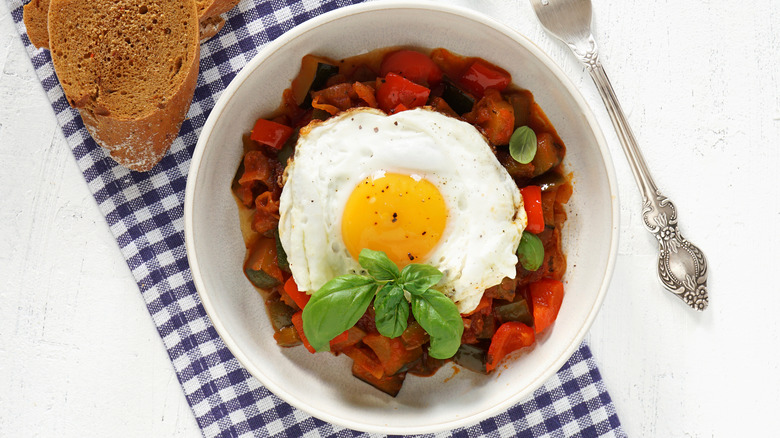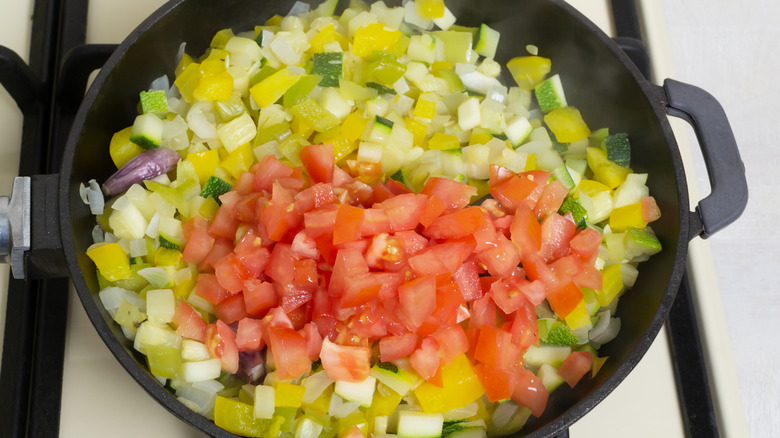Pisto: The Spanish Vegetable Stew With Ancient Origins
Ever since childhood, eating our vegetables has been an eternal struggle. In fact, three out of four Americans wish they ate more of them (via Study Finds). Many of these individuals reported that their vegetables either spoil too quickly or are too expensive to be a regular part of their diet. A significant number also found it hard to include them in meals because they didn't know how to cook them.
For those that want to add more vegetables to an easy-to-cook meal, look no further than pisto. The Washington Post says this Spanish dish consists of various stewed veggies cooked in olive oil. It's a hardy, vegetable-laden meal that is simple to assemble and even more satisfying to enjoy. It's also easy to be customized and has several regional variations, according to Spain's News. This way, it can be designed to suit anyone's tastes while packing in several servings of vegetables.
What is pisto?
The Washington Post says that one of the qualities that make pisto unique is that the vegetables are stewed entirely in their own juices. There is no additional water, broth, or sauce involved. Simply cook down the different vegetables, and let their moisture and oils create a hardy sauce. The Stingy Vegan says that the basic ingredients required for pisto are onions, tomato, and red or green bell peppers. They are all cooked together with a healthy dose of olive oil, which adds its own flavor to the mix. Pisto, like many other dishes, has traveled far and wide through Spain, and in its travels, it has taken many forms. Each region, town, and even family has its own variations and methods for preparing it. Pisto can be served as an appetizer, side, or even as a main course with meat or fish.
It's important not to confuse this dish with the South American brandy, Pisco. Also, World Food Story notes that pisto is also often compared to the classic French dish, ratatouille. It's debated which meal inspired the other, but both have become staple recipes throughout Europe. This is especially true during the summer when vegetables are at their most ripe and lend their fresh flavors to the stew. The main difference is that the vegetables are typically cut much smaller for pisto than ratatouille. Besides this, they are essentially different versions of the same stewed vegetables.
History of pisto
Much like the iconic Spanish dish of paella, pisto's roots come from Spain's Moorish influence. According to 196 Flavors, it is believed to have descended from al-buraniya, a meal developed to celebrate the wedding of a Moorish princess named Būrān. One of pisto's primary flavors is thanks to the Moors as well. They introduced olive oil production to the region while they occupied the Iberian Peninsula. It would eventually become a key ingredient in Spanish cuisine and serve as the primary base for pisto.
Despite its Moorish origins, pisto remained a popular Spanish recipe once the natives reclaimed the area. World Food Story says that the dish became a trademark of the region of Murcia, specifically in Extremadura and Castilla-La Mancha.
Today, pisto exists as a known staple throughout the country. It has even become so synonymous with Spanish culture that Spanish chef José Andrès chose it as one of the dishes to send to the International Space Station to feed hungry astronauts.
Ingredients and variations
The ingredients of a pisto can vary between different versions. According to The Stingy Vegan, the base is usually a mixture of onions, tomato, and bell peppers. However, if you were to add zucchini, you would have pisto manchego, and if you used eggplants instead, it would be pisto murciano. These two are some of the most common varieties of the dish. Spain's News says that you can also include these ingredients along with pumpkin to make alboronia, which is the most direct descendant of the original al-buraniya recipe.
Delighted Cooking adds that while it isn't always recommended, pisto can also be seasoned to individual tastes. Feel free to add garlic, basil, cumin, paprika, or red pepper flakes into your stew to add more complex layers of savory flavor.
The various toppings used for a pisto can also drastically alter the taste. The Washington Post notes that pisto can be served alongside meat and fish, topped with fried manchego cheese or eggs, stuffed inside an empanada, spread on toast, or even used as a pasta sauce.
Nutrition
Pisto is a great meal full of nutrition thanks to its high vegetable content. According to the CDC, the average adult should consume approximately 2 to 3 cups of vegetables per day, but only about one in ten adults manage to do so. Because pisto is almost entirely vegetables, it can make a huge dent in this nutrition goal.
Each of the ingredients used also has its own benefits as well. Medical News Today declares tomatoes are a "nutrient-dense superfood." Studies have found that tomatoes can help protect eyesight, help maintain healthy blood pressure, and even prevent cancer. According to Live Science, onions are another cancer-fighting veggie. They contain high levels of the antioxidant quercetin, which may be linked to cancer prevention. Healthline adds that bell peppers are also low in calories and have high levels of vitamin C.
These three vegetables each pack a powerful nutritious punch on their own and come together to form a holy triad when they intermingle as a part of pisto. Olive oil is also known for its healthy fats, and adding spices like garlic will also have additional health benefits.
How to make pisto
Making pisto is a simple step-by-step process. 196 flavors says that the key to creating A+ pisto is to add one ingredient at a time. Start by heating oil in a large pan, then add the onions and some salt. Once it cooks down, add the peppers, and once they've softened, add the tomatoes. Then, let everything simmer and meld together.
Most of the work will come from the time it takes to prep your vegetables and cut them into equal-sized chunks. As The Stingy Vegan points out, though, you can easily do this work while the pisto cooks. Each vegetable needs a few minutes to break down before the next is added, so you can easily cut up your bell peppers while the onions simmer, and the same goes for any eggplant or zucchini you might want to add after. The Washington Post also recommends using a box grater to easily break down and skin lots of tomatoes. You can also save yourself some time by working with canned tomatoes instead.
From there, it's up to you to decide whether you want to add other seasonings to the mix while the food simmers or to top it with a fried or poached egg. That's the beauty of pisto, though. It's a healthy, flavorful base that can be customized to suit your tastes and preferences.
